May 2019
URL: http://www.kingcorn.org/news/timeless/VStageMethods.html
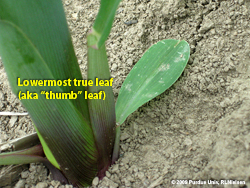
The lowermost, thumb-shaped leaf of a corn plant.
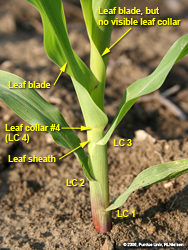
Parts of a corn leaf.
Determining Corn Leaf Stages
R.L. (Bob) Nielsen
Agronomy Dept., Purdue Univ.
West Lafayette, IN 47907-2054
Email address: rnielsen at purdue.edu
Twitter: @PurdueCornGuy
![]() any of us remember standing against the doorframe in our early years while our parents marked our height with a pencil to measure how much we had grown. Some of you may have spent more time in your youth standing in the corner, but that is between you and your parents.
any of us remember standing against the doorframe in our early years while our parents marked our height with a pencil to measure how much we had grown. Some of you may have spent more time in your youth standing in the corner, but that is between you and your parents.
Because it is difficult to transport corn plants from the field to that doorframe to measure their growth, agronomists developed other means to measure the phenology or development of corn. Counting the number of leaves would seem to be a simple way to document corn development, but folks still tend to become confused over this simple strategy. There are two basic methods for leaf staging corn that are used by agronomists and hail loss adjusters in the field today.
Leaf Collar Method. This method determines leaf stage in corn by counting the number of leaves on a plant with visible leaf collars, beginning with the lowermost, short, rounded-tip true leaf and ending with the uppermost leaf with a visible leaf collar (Abendroth et al., 2011). The leaf collar is the light-colored collar-like “band” located at the base of an exposed leaf blade, near the spot where the leaf blade comes in contact with the stem of the plant.
Leaves within the whorl, not yet fully expanded and with no visible leaf collar are not included in this leaf staging method. The exception to this statement may be that leaves with barely visible leaf collars can be counted when you are staging plants early in the day, recognizing that the leaf collar may become completely visible by the end of the day.
Leaf stages are usually described as “V” stages, e.g., V2 = two leaves with visible leaf collars. The leaf collar method is generally the most widely used method by university and industry agronomists in the U.S.
TIP: Recognize that not all plants in a given field will be at the same leaf stage at the same time due to normal variability among plants for emergence or subsequent exposure to stress. By definition, the specific leaf stage for an entire field is defined by that value that represents the majority of the plants in the field (Abendroth et al., 2011). For example, if half or more of the plants you rate are at the V5 stage of development, then the entire field is assigned a V5 rating.
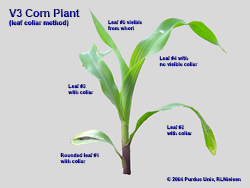
Young corn plant staged as V3 according to the collar method.
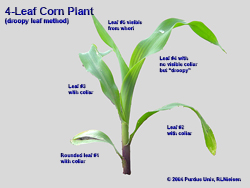
Same plant, but staged as 4-leaf according to the "droopy" method.
“Droopy” Leaf Method. Crop insurance adjusters, when assessing damage to a corn crop from weather events such as hailstorms, use this leaf staging method. Like the leaf collar method, this method of leaf staging begins with the short first leaf. Leaf counting then differs, though, by ending not with the uppermost leaf with a visible collar, but at that leaf that is at least 40 to 50 percent exposed from the whorl. In knee-high corn or older, the tip of this “indicator” leaf typically also “droops” or hangs down, thus I refer to this as the “droopy” leaf method.
The Two Methods Compared. Both methods assign a leaf stage to a field on the basis of the leaf stage common to the majority of the plants in the field. Up to the 5- or 6-leaf collar stage, the leaf collar method will typically result in a leaf stage value that is numerically one less than the “droopy” leaf method. For example, the images to the left show the same corn plant that could be staged either as V3 by the leaf collar method or as a 4-leaf plant by the "droopy" leaf method. After corn reaches 18 to 24 inches in height, the leaf collar method will typically result in a leaf stage value that is numerically two less than the “droopy” leaf method.
The usefulness in understanding the differences between these two leaf staging methods lies in the fact that the yield loss chart used by hail insurance adjusters to estimate yield loss due to defoliation is based on the “droopy” leaf method. That chart is reproduced in the Purdue Extension publication ID-179, Corn & Soybean Field Guide.
Identifying true “droopy” leaves on shredded, hail-damaged corn plants can be quite difficult, whereas leaf collars are often still identifiable. Thus, you can usually stage a damaged crop by the leaf collar method and then add one or two more leaves to the count in order to use the defoliation chart. See my Corny News article for more details.
What About Herbicide Labels? Growers’ confusion with leaf staging often originates with less than clearly described growth stage restrictions listed on herbicide labels (Ikely and Johnson, 2018). Label restrictions of older post-emergence herbicides typically ignored the short first leaf with the rounded tip and ended with the uppermost leaf that was at least 50% exposed from whorl. In essence, this was a bastardized “droopy leaf” method that resulted in roughly the same numerical leaf stage as the leaf collar method. Newer labels purport to define leaf stages according to the leaf collar method, but there is still some question about whether the short first leaf with the rounded tip is included. If in doubt with these newer herbicides, check with your agricultural chemical technical representative to verify which leaf staging method is appropriate for the herbicide you intend to use.
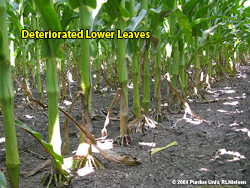
Typical deterioriation of lower leaves in older corn plants.
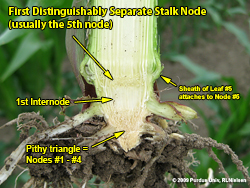
Split stalk illustrating the first distinguishable node above the pithy triangle.
Staging Older Plants. As corn plants develop, the lower few leaves typically die or are torn away from the stem by the expansion of the stalk or by developing roots. Consequently, growth stage identification can be difficult on older plants when you aren't sure which leaves to begin counting first. But, not to worry, such plants can still be staged!
First, dig or pull a plant without breaking the stalk. With a knife, carefully split the stalk down the middle, completely through the root ball. Look for the lowermost obvious internode (the whitish area between the “woody” horizontal stalk nodes) above the triangular “woody” base of the stalk. The length of this first internode is typically only 1/2 to 3/4 inch (1.3 to 1.9 cm for you fans of the metric system).
Determine which leaf corresponds with the node immediately above the first noticeable internode by carefully identifying which leaf sheath attaches to the node. This leaf is usually Leaf #5. Once Leaf #5 is identified, then stage the plant by continuing to count the remainder of the leaves with visible leaf collars above Leaf #5. For example, assume you’ve identified Leaf #5 and there are six more leaves above that one with visible leaf collars, then the plant is at leaf stage V11 (11 leaves with visible leaf collars).
Useful Tip: Even though one or more lower leaves may have "disappeared" due to injury or natural senescence, their absence does not mean they should be forgotten or ignored. In other words, a plant that is assessed at being at the V12 stage as a result of the previously described stalk splitting steps may only have 8 leaves with visible leaf collars if 4 lower ones have already withered away. Do not be misled into thinking the plant is only at the V8 stage.
Related References
Abendroth, L.J., R.W Elmore, M.J. Boyer, and S.K. Marlay. 2011. Corn Growth and Development. Iowa State Univ. Extension Publication #PMR-1009. https://store.extension.iastate.edu/Product/Corn-Growth-and-Development [URL accessed May 2019].
Ikley, Joe and Bill Johnson. 2018. Growth Stage Cutoffs for Herbicide Applications in Corn and Soybean. Pest & Crop Newsletter, Purdue Univ. Extension. https://extension.entm.purdue.edu/newsletters/pestandcrop/article/growth-stage-cutoffs-for-herbicide-applications-in-corn-and-soybean [URL accessed May 2019].
Nielsen, R.L. (Bob). 2017. Heat Unit Concepts Related to Corn Development. Corny News Network, Purdue Univ. [On-Line]. Available at http://www.kingcorn.org/news/timeless/HeatUnits.html. [URL accessed May 2019].
Nielsen, R.L. (Bob). 2019. Tips for Staging Corn with Severe Leaf Damage. Corny News Network, Purdue Univ. [On-Line]. Available at http://www.kingcorn.org/news/timeless/VStagingTips.html. [URL accessed May 2019].
Nielsen, R.L. (Bob). 2019. Use Thermal Time to Predict Leaf Stage Development in Corn. Corny News Network, Purdue Univ. [On-Line]. Available at http://www.kingcorn.org/news/timeless/VStagePrediction.html. [URL accessed May 2019].
Purdue University. 2019. Corn & Soybean Field Guide (ID-179). Purdue Univ. Extension. https://ag.purdue.edu/agry/dtc/Pages/CSFG.aspx [URL accessed May 2019]